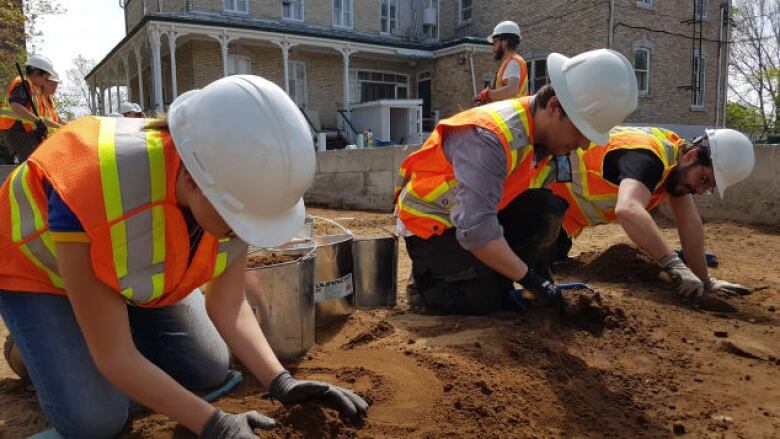Archeologists dig up more than 350 years of history near Quebec City
50,000 artifacts discovered on the grounds of former church, some date back more than three centuries

Archeologists have unearthed more than 50,000 artifactsdating back more than three centuries on the quiet grounds of a former Catholic church, justwest of Quebec City.
The site in L'Ancienne-Lorette, Que., has revealed itself to be a real treasure trove of discoveries, said lead archeologist Stphane Nol.
"We really have close to 350 years of history on the site," saidNol, who is working as part of anarcheologist workers' cooperative, GAIA, on the eight-week excavation.
A new community centre is expected to be built on the land, which has also since been used as a parking lot.
Members of the Huron-Wendat First Nation lived in the area with Jesuit priests in 1673, Nol explained, before the Bishop of Quebec City pressured them to leave the site two decades later to make way for French inhabitants.
They, too, eventually hadto leave during the winter of 1759 and1760 to make room for the British army.
The objects each group of former inhabitants left behind have been exceptionally well-preserved within the soil, Nolsaid.

"What's exceptional is the integrity, the incredible preservation of the archeological layers, and the quantity of artifacts that we've been able to gather," he said.
In 2013,Nolexcavated a nearby area that once housed a chapel, so he said he knewthe area was rich with potential.
This time, he recommended bringing in a complete excavation team,getting 30 archeologists and other specialists to take part in the excavation.
As many as 70,000 artifacts could be discovered in the 400 square-metre area by the time the team's work wraps up this week, he said.
"The presbytery grounds in L'Ancienne-Lorette is one of the region's most important archeological sites in recent years."
Important site for local First Nation community
The grounds provide a look at a unique period in Huron-Wendat history, as the First Nation'slonghouseswere built around French colonists' buildings there for 23 years.
"It's a unique site in Canada," said Louis Lesage, director of the NionwentsoOffice, which protects the ancestral territory of the Huron-Wendat in the area.
"A lot of French sites have been excavated in Quebec and Canada. A lot of English sites have been excavated in Quebec and Canada, but this is the only site where we have a fusion between a First Nation and the French epoch."

Lesage is able to trace his own family tree back 13 generations, starting at the L'Ancienne-Lorette site.
"All our genealogical trees start in L'Ancienne-Lorette," he said.
The current work has revealed stories the Jesuit priests who lived with the Huron-Wendat did not bother to write down, including how the First Nation people's liveswere changing.
For example, archeologists including two from the Huron-Wendat community have dug up one of the largest collections of stone pipes in the province, demonstrating that they were still carving their own despite access to European goods.
They were also repurposing European gun flints as scrapers and drills.
Artifacts will be returned to the Huron-Wendat
One of the most prized finds to date is a pendant carved into the shape of a beaver andmade out of red argillite stone that likely came from Minnesota.

Researchers have also uncovered shell pendants and beads from an Atlantic whelk species evidence of how extensive the Huron-Wendat's trade network was.
All the artifacts related to the Huron-Wendatwill be given back to the community after the excavation is completed. - a first in Quebec, said Konrad Sioui, the Grand Chief of Wendake, a local Huron-Wendat territory.
Like many First Nations, the Huron-Wendat have struggled to repatriate their traditional artifacts, scattered across the globe, and these finds will more than double their collection, Sioui said.
"Sometimes [the Huron-Wendat objects have] been stolen;sometimes [they've] been sold by our own. There are all kinds of situations, but today we celebrate," he said.
British armycannon ball discovered
Archeologists are also uncovering more than 300 years of history attached to the French settlement in the area, including a nearly intact ice house that inhabitants once packed with snow to preserve their food during warmer months of the year.
The British also occupied the church area for a winter during their conquest of New France, leaving behind the site's most surprising artifact a cannon ball.

The team had not expected to find much of a trace of the British presencesince the army was only there for a season, but Nolsaid there's no other explanation for where the projectile came from.
"The priests did not have cannons," he said.
The archeologists' work is also bolstered by the wealth of high-quality, historic documents that accompany the site.
Meanwhile, the cannon ball, as well as any other objects tied to the area's former French and British inhabitants, will be passed on to the city ofL'Ancienne-Lorette, which intends to eventually put them on display.
With files from Aakruti Patel, Alexandre Duval, Tifa Bourjouane and Radio-Canada












_(720p).jpg)


 OFFICIAL HD MUSIC VIDEO.jpg)
.jpg)



























































































